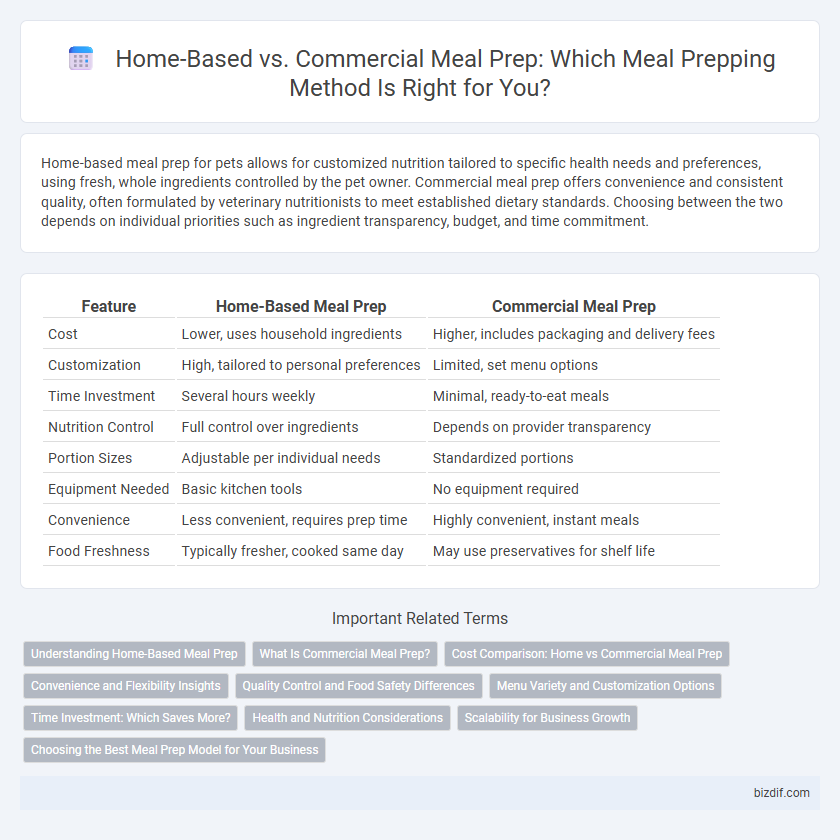Home-based meal prep for pets allows for customized nutrition tailored to specific health needs and preferences, using fresh, whole ingredients controlled by the pet owner. Commercial meal prep offers convenience and consistent quality, often formulated by veterinary nutritionists to meet established dietary standards. Choosing between the two depends on individual priorities such as ingredient transparency, budget, and time commitment.
Table of Comparison
| Feature | Home-Based Meal Prep | Commercial Meal Prep |
|---|---|---|
| Cost | Lower, uses household ingredients | Higher, includes packaging and delivery fees |
| Customization | High, tailored to personal preferences | Limited, set menu options |
| Time Investment | Several hours weekly | Minimal, ready-to-eat meals |
| Nutrition Control | Full control over ingredients | Depends on provider transparency |
| Portion Sizes | Adjustable per individual needs | Standardized portions |
| Equipment Needed | Basic kitchen tools | No equipment required |
| Convenience | Less convenient, requires prep time | Highly convenient, instant meals |
| Food Freshness | Typically fresher, cooked same day | May use preservatives for shelf life |
Understanding Home-Based Meal Prep
Home-based meal prep allows individuals to control ingredient quality, portion sizes, and dietary preferences, promoting personalized nutrition and cost savings. It often involves batch cooking in a familiar kitchen environment, reducing food waste and increasing convenience for busy schedules. Understanding home-based meal prep includes mastering time management, recipe selection, and proper food storage techniques to ensure freshness and safety.
What Is Commercial Meal Prep?
Commercial meal prep involves professional kitchens or companies preparing large quantities of meals for retail, delivery, or institutional use such as schools and hospitals. These operations utilize standardized recipes and bulk ingredients to ensure consistency, cost-efficiency, and compliance with health regulations. Unlike home-based meal prep, commercial meal prep benefits from specialized equipment, trained staff, and scalability to meet widespread demand.
Cost Comparison: Home vs Commercial Meal Prep
Home-based meal prepping significantly reduces costs by utilizing bulk ingredient purchases and eliminating labor fees, with average weekly expenses ranging between $30 to $50. In contrast, commercial meal prep services typically charge $8 to $12 per meal, resulting in monthly costs upwards of $240 for three meals a day. While commercial options offer convenience, home meal prepping remains the most economical choice for budget-conscious consumers.
Convenience and Flexibility Insights
Home-based meal prep offers unparalleled flexibility, allowing individuals to customize meals according to dietary preferences and schedule constraints, enhancing convenience for busy lifestyles. Commercial meal prep services provide time-saving solutions with professionally prepared, portion-controlled meals, ideal for those seeking efficiency without sacrificing nutritional quality. The choice depends on balancing personal control over ingredients and time management needs within everyday routines.
Quality Control and Food Safety Differences
Home-based meal prepping allows for meticulous quality control through direct ingredient selection and personalized preparation methods, minimizing contamination risks. Commercial meal prep facilities implement stringent food safety protocols and standardized procedures to comply with regulatory standards and handle large-scale production efficiently. Differences in food safety measures primarily stem from scale, with commercial operations relying more on technology and audits, whereas home-based prep depends on individual vigilance and hygiene practices.
Menu Variety and Customization Options
Home-based meal prep offers greater menu variety and customization options, allowing individuals to tailor ingredients and portion sizes to specific dietary needs and preferences. Commercial meal prep services provide a wide range of pre-designed meals but typically offer limited flexibility in ingredient substitutions and portion adjustments. While commercial options prioritize convenience and consistency, home-based prep ensures personalized nutrition and diverse menu creativity.
Time Investment: Which Saves More?
Home-based meal prepping requires a significant initial time investment for planning, shopping, and cooking but can save hours throughout the week by reducing daily meal decisions and preparation. Commercial meal prep services offer convenience by delivering pre-portioned meals, cutting down daily cooking time, but often involve limited customization and higher costs. Evaluating time saved depends on individual schedules, prioritizing either upfront preparation effort or ongoing convenience.
Health and Nutrition Considerations
Home-based meal prep allows precise control over ingredient quality, portion sizes, and dietary restrictions, promoting tailored nutritional benefits and minimizing additives or preservatives. Commercial meal prep often prioritizes shelf life and convenience, sometimes incorporating higher sodium, preservatives, and processed ingredients that may impact long-term health. Evaluating macros, micronutrients, and food sourcing is essential when choosing between home-based and commercial options to meet specific health goals.
Scalability for Business Growth
Home-based meal prep offers limited scalability due to constrained kitchen space, equipment, and labor capacity, making it challenging to meet increasing demand. Commercial meal prep facilities provide scalable infrastructure, advanced machinery, and streamlined logistics designed to support large-volume production and rapid business expansion. Investing in commercial operations enables meal prep businesses to optimize workflow, reduce per-unit costs, and significantly increase output for sustained growth.
Choosing the Best Meal Prep Model for Your Business
Choosing the best meal prep model for your business depends on factors like scale, target market, and budget. Home-based meal prep offers lower startup costs and personalized service, ideal for small-scale or niche markets. Commercial meal prep requires higher investment but supports larger production volume, streamlined operations, and scalability for growing demand.
Home-Based Meal Prep vs Commercial Meal Prep Infographic

 bizdif.com
bizdif.com